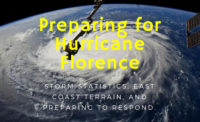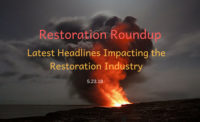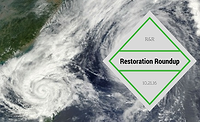Restoration Roundup: Hurricane Florence | 9.17.18
$20 Billion Threat for Insurers, Opportunity for Restorers

Want to catch up on industry-related news, but no time to surf the web? R&R is here to help with this brand, regular new web-exclusive. The headlines you need, all in one place.
Headlines from Sept. 15-17, 2018
Florence Leaving Catastrophic Flooding in Carolinas [Photos]
Florence’s plodding pace and catastrophic flooding could produce as much as $18 billion in damage and has already caused at least six deaths, even as it has weakened to a tropical storm. As much as 2 feet of rain has fallen across southeastern North Carolina, submerging cities, ravaging tobacco crops and threatening the large and environmentally precarious hog industry. The storm is creeping west at 3 mph (5 kph), with torrents forecast as the storm moves inland, the National Hurricane Center said.
'There is No Access to Wilmington' as Florence Flooding Overwhelms North Carolina
Storm-weary residents of North Carolina struggled Monday to loosen the grip of Florence, the lingering killer that has closed more than 100 roads, cut off power to almost 500,000 homes and businesses and essentially cut off the city of Wilmington from the world.
Coal Ash, Sewage Spill Over as Florence Floods the Carolinas
A Duke Energy Corp. landfill near Wilmington, North Carolina, failed under the assault of Tropical Depression Florence, spilling about 2,000 cubic yards of coal ash that can carry toxic mercury, arsenic and lead. Authorities said they would investigate whether the pollutant had reached the Cape Fear River, but said it wasn’t yet safe to inspect the site.
At Least 11 Dead as Florence Brings Catastrophic Flooding to Carolinas
Hurricane Florence made landfall on Friday, September 14 near Wrightsville Beach, North Carolina as a Category 1 hurricane. Now downgraded to a tropical storm, slow-moving Florence has brought devastating flooding to the Carolinas, particularly North Carolina, and officials say the storm won’t let up until Tuesday at the earliest.
Headlines from Sept. 13, 2018
Hurricane Florence Starts to Hit Carolina Coast with High Winds and Rushing Seas
Hurricane Florence's heavy rains and tropical storm-force winds reached North Carolina's Outer Banks on Thursday morning, leading the way for a storm packing 105-mph winds. Florence has weakened a bit over the past 24 hours, but it has also grown larger and will likely dump torrential rain over North and South Carolina through Monday.
"Disaster is at the Doorstep"
"Disaster is at the doorstep and is coming in," North Carolina Gov. Roy Cooper said. "If you are on the coast, there is still time to get out safely." The time to prepare is almost over, he said. In addition to the dangers the expected deluge of water poses, the hurricane center cautioned, "A few tornadoes are possible in eastern North Carolina beginning late Thursday morning."
Don't Pay Attention to the Hurricane Category
The scale’s inventors—Herbert Saffir, an engineer, and Robert Simpson, a meteorologist—hoped their scale would measure a storm’s total destruction potential when they developed it in 1971. But their system omits a tremendous amount of information about a storm’s ferocity.
Headlines from Sept. 12, 2018
Hurricane Florence Poses $20 Billion Threat for Insurers if History Repeats
Experts at CoreLogic warn that approximately 758,657 homes in North Carolina, South Carolina and Virginia are at risk of storm surge based on Florence’s current Category 4 status. CoreLogic data analysts put the total reconstruction cost value (RCV) of these homes at approximately $170.2 billion. Catastrophe modeler Risk Management Solutions (RMS) cited the potential for Hazel or Hugo type losses at a reconstructed loss value between $15—20 billion.
Hurricane Florence Could Knock Out Power, Vital Infrastructure for Weeks, FEMA Warns
It could take weeks before power is restored and vital infrastructure repaired once Hurricane Florence ends its assault on the Southeast, the Federal Emergency Management Administration warned this week. While uncertainty remains on where the brunt of the storm will occur, FEMA officials say damage from high winds and flooding will leave areas without power for an extended period. “The storm is going to definitely knock out power for days into weeks,” Jeffrey Byard, Associate Administrator for FEMA’s Office of Response and Recovery, told reporters during a Tuesday press conference. “It’s going to destroy infrastructure, going to destroy homes.”
Hurricane Florence from Space: Chilling Images Show Colossal Storm Churning Toward U.S.
A monstrous hurricane barreling toward the United States is just as frightening from the ground as it is from space. A high-definition camera outside the International Space Station captured an overhead look at Hurricane Florence on Wednesday morning, as the Category 4 storm churned across the Atlantic Ocean with sustained wind speeds of up to 130 mph. NASA, which posted the video on its blog, described it as a "stark and sobering view."
Hurricane Florence Path Shifts: "Storm of a Lifetime" Headed to Carolina Coast
An immensely powerful Hurricane Florence slowed its approach to the East Coast on Wednesday but was expected to take a dangerous turn south and stall along the edge of North Carolina and South Carolina – bombarding the area with torrential rain, high winds and deadly storm surge Thursday through Saturday. Hurricane winds could linger for 24 hours or more, sweeping away trees and power lines while dumping 20 to 30 inches of rain in some coastal areas, the National Hurricane Center said. Isolated totals of 40 inches are possible.
What Wireless Providers Are Doing to Prepare for Hurricane Florence
As millions evacuate the mid-Atlantic coastal region ahead of Hurricane Florence, wireless providers are mounting an invasion of support crews and high-tech machinery to repair and restore connectivity in the storm's wake. The incursion includes a menagerie of machines with animal monickers meant to help mend the hurricane-hit area's communications network. There are COWs (cells on wheels and wings), COLTs (cells on light trucks), CROWs (cellular repeaters on wheels), GOATs (generators on a trailer) and Spiders, webs of circuitry meant to improve connectivity in places such as hotels, command centers and temporary shelters.
Looking for a reprint of this article?
From high-res PDFs to custom plaques, order your copy today!






